PATIENT INFORMATION: Dental Implants
SOME HANDY HELPS
patient checklist before deciding
how does a dental implantation procedure work?
how do I prepare for a dental implant procedure?
what do I have to pay attention after a dental implantation?
how do I care for my dental implant?
•
WHAT … FOR ? (Indications)
Dental implants serve
- as replacement of teeth,
- to avoid grinding of teeth for crowns/bridges,
- to hold bridges,
- to stabilize dentures,
- for functional reasons (joint, face muscles),
- for esthetic reasons and
- as orthodontic anchor (temporary)
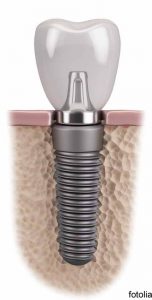
The graphic shows a typical implant consisting of a metallic screw fixed in the bone. Into this an abutment is placed, which in turn supports the visible dental crown.
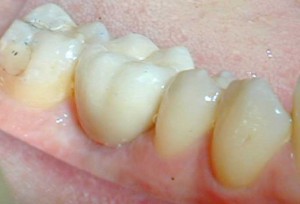
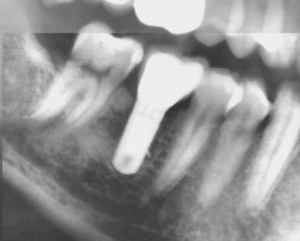
lower molar implant (Xray shows the same)
◊ In some cases, there are alternatives to dental implants such as bridges, adhesive bridges, orthodontic treatment and removable dentures.
NUMBERS
- There are no current, reliable and comparable data known, but rough estimates.
- USA: 3 Million people have 8.6 Mio implants (AAID 2016).
- USA: About 300.000 to 400.000 dental implants are placed per year in the USA (carefree).
- About 1.3 Mio dental implants are placed per year in Germany (DGI 2017, Symposium 2018, Wiesbaden).
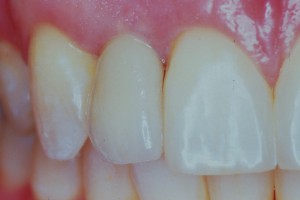
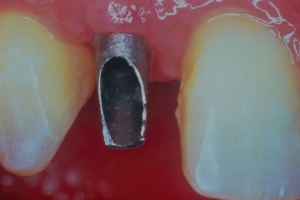
Implant with and without visible dental crown in an upper smile area
TIMES
- Many different techniques take different times.
- Healing times are shorter with 3D-supported techniques.
- Faster if no bone augmentation needed. Often loss of bone needs some reconstruction.
- Healing phase after placing takes usually 2-6 month.
- Under certain preconditions immediate loading (usually reduced use after placing) is possible.
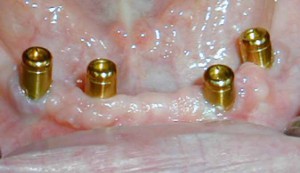
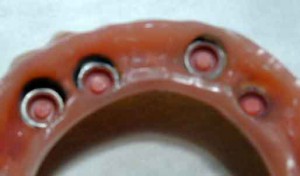
snapping attachments example to hold a denture and the counterparts within the denture
this is how a prosthesis can be fixed stably
CONTRAINDICATIONS (may be relative if preconditions can be changed)
- behavioral
Poor oral hygiene, smoking, parafunction, no aftercare possible. - medical
Diabetes mellitus, infectious diseases, certain systemic/metabolism diseases, low ability for surgery, low bone quality, bone loss (see bone augmentation). - pharmaceutical
Biphosphonates, chemotherapy, drugs, alcohol, corticosteroids, immune suppression, antidepressants, proton pump inhibitors.
RISKS
- at surgery
Tissue injury, swallowing/inhaling parts, bone fracture, injury of neighbouring teeth or structures/nervs. - short term
Inflammation, injury of neighbouring teeth or structures.
Foreign body reactions, allergic reactions, rejection.
- long term
Implant dislocation, chronic inflammation, chronic pain, reoperation, fracture, implant loss.
Superstructure (Crown/Bridge/Denture): loosening, fracture.
FAILURES
Risks depend from several preconditions like bone volume, bone quality, superstructure and reasons in connection with the above contraindications.
There are problems reported with abutments on implants (which may be renewed without surgery), but not with implants themselves.
MATERIALS
- Titanium: mostly Grade 4, Grade 5
- Ceramic: Zirconium dioxide ceramic
- PEEK: Polyetheretherketone
Dental implants come with many sizes and shapes. Most of them are screws, but blades, discs are used too. 3D-techniques allow individual designs. The surface of the implant is important (cleanliness, roughness, coating).
STATISTICS
- Survival Analysis of Dental Implants, Andrew Kai-Ming Kwan et al: after 5 years 94.4% https://www.statistics.gov.hk/wsc/CPS014-P5-S.pdf
- Survival rates range from 91 – 97% since the late 1990ies (Knöfler 2004)
- Failing rate after 20 years 20.7% (range 2.6-54.3% according to system) (Gomez G, et al. 1996)
- Failure rate after 10 years with augmentations 26.7% (Schliephake H et al. 1997)
- The way the superstructure (crowns/bridges/dentures) is made is important in a long run (Knöfler, 2004)
- Patients experiencing technical and/or biological complications over a 9-year period was 42% (Department of Periodontology Institute of Odontology, Sahlgrenska Academy, University of Gothenburg, Sweden, 2021)
LITERATURE
- Problems
Most problems happen in the 1st year. No material related problems. - Study warns of rare risk of chronic pain from dental implant surgery (Devine et al. Eur J Oral Implantol 9(2):179-186)
- Science/Future
Most implants today are made of titanium. Ceramics have been increasingly important in recent times, plastics or derivatives might be an alternative too. Stem cell treatment seems to be possible.
CRITICISM
In Dental Implantology has to be discussed at which point a natural tooth may be maintained or not.
SELECTED PATIENT INFORMATION
Topics to be discussed while planning: Individual risks, sufficient bone or bone augmentation needed (see chapter on oral bone and soft tissue), 3D-planning necessary, pretreatment necessary, surgical guide necessary, alternative solutions, preparation, aftercare.
Questions to ask your dentist before getting dental implants (printable text): (english) (deutsch)
Dental implants – What you should know (FDA, U.S.A.)
Implantate – die unsichtbaren Dritten (german text)
Brücke oder Implantat – Was ist besser? (german video)
Kein Geld für Zahnimplantate – Welche Alternativen gibt es? (german video)
Find here all companies showing patient information: ![]()
There are no dental implant companies showing doctor/clinic lists known at us: ![]()
Find here dental societies showing doctor/clinic lists: ![]()
IMPLANT PATIENT REGISTER
No register known (except for Implant-Register®). Implants are identifiable. Patients usually get a documentation (implant-passport or certificate), important for longterm care.
Identifying an unknown implant? If you don´t find it at Implant-Register®, maybe WHAT IMPLANT IS THAT? or Osseosource helps.
In the register of the registries you can check which ones are available.
The Implant-Register offers registration of implants online (fee) and you can download a printable version for your personal use (free). You may also ask your doctor or the manufacturer doing the registration with us.
It is useful to know which implant you have had inserted if problems with the implant occur later or, for example, the doctor or company can no longer be contacted.
MEDICAL SOCIETIES dealing with dental/oral implantology are listed here
| Disclaimer The information and links and whatsoever shown on this page are compiled with care. However, Implant-Register can´t take any responsibility for the information given, nor their content, nor their up-to-date nature, particularly in interlinked pages. You may help us with your contribution, granting us the decision to publish or not. Be careful with conclusions for yourself, in doubt double-check and consider medical solutions are individual and have to be found with an educated medical person. |
